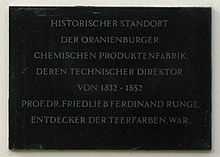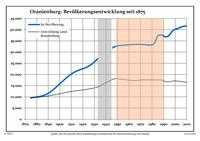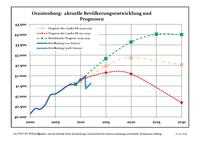Oranienburg
| Oranienburg | ||
|---|---|---|
 | ||
| ||
 Oranienburg | ||
Location of Oranienburg within Oberhavel district  | ||
| Coordinates: 52°45′16″N 13°14′13″E / 52.75444°N 13.23694°ECoordinates: 52°45′16″N 13°14′13″E / 52.75444°N 13.23694°E | ||
| Country | Germany | |
| State | Brandenburg | |
| District | Oberhavel | |
| Subdivisions | 9 districts | |
| Government | ||
| • Mayor | Hans-Joachim Laesicke (SPD) | |
| Area | ||
| • Total | 162.37 km2 (62.69 sq mi) | |
| Elevation | 34 m (112 ft) | |
| Population (2012-12-31)[1] | ||
| • Total | 41,621 | |
| • Density | 260/km2 (660/sq mi) | |
| Time zone | CET/CEST (UTC+1/+2) | |
| Postal codes | 16515 | |
| Dialling codes | 03301 | |
| Vehicle registration | OHV | |
| Website | www.oranienburg.de | |
Oranienburg is a town in Brandenburg, Germany. It is the capital of the district of Oberhavel.
Geography
Oranienburg is a town located on the banks of the Havel river, 35 km north of the centre of Berlin.
Division of the town
Oranienburg consists of 9 districts
- Friedrichsthal
- Germendorf
- Lehnitz
- Malz
- Oranienburg
- Sachsenhausen
- Schmachtenhagen
- Wensickendorf
- Zehlendorf
History
The original name of Oranienburg was Bötzow. The town was founded in the 12th century and was first mentioned in 1216. Albert the Bear is believed to have ordered the construction of a castle on the banks of the Havel. Around the castle there was a settlement of traders and craftsmen.
In 1646, Friedrich Wilhelm I of Brandenburg married Louise Henriette of Orange-Nassau (German: Oranien-Nassau). She was so attracted by the town of Bötzow, that her husband presented the entire region to her. The princess ordered a new castle to be built in the Dutch style and called it Oranienburg or Schloss Oranienburg. In 1653, the town of Bötzow was renamed Oranienburg.
Silvio Gesell, the founder of Freiwirtschaft, lived in Oraninburg between 1911 an 1915, publishing his magazine, "Der Physiocrat". He returned to the town in 1927 and lived there up to his death in 1930. The town remained a center of the free economy movement until it was outlwed by the Nazi regime in 1933, and many of Gessel's followers ended up as prisoners in the town's concentration camp.
One of the first Nazi concentration camps was built in Oranienburg in 1933. In 1936 it was replaced by the Sachsenhausen concentration camp which continued to operate until the end of the Nazi regime; 200,000 people were interned in Sachsenhausen over the 9 years the camp was operational under the Nazis. 22,000 were murdered by the Nazis before the liberation of the camp by the Soviet Red Army in 1945. Following this the site was reopened in August 1945 as Soviet Special Camp 7. A further 12,000 people (mostly Nazis not awaiting trial) died under the Soviets before the Special Camp was closed in 1950. Their remains were not discovered until the 1990s.
Oranienburg was also the center of Nazi Germany's nuclear energy project and according to military historian Antony Beevor, the launching of the Battle for Berlin by Stalin was motivated by his desire to acquire that facility.[2] It has also been claimed that the preemptive destruction of these facilities by the USAAF Eighth Air Force on March 15, 1945, was done so as to prevent it from falling into Soviet hands.[3]
International relations
Oranienburg is twinned with:
-
 Bagnolet (France) -- since 1964
Bagnolet (France) -- since 1964 -
 Hamm (North Rhine-Westphalia, Germany) -- since 1990
Hamm (North Rhine-Westphalia, Germany) -- since 1990 -
 Mělník (Czech Republic) -- since 1974
Mělník (Czech Republic) -- since 1974 -
 Vught (Netherlands) -- since 2000
Vught (Netherlands) -- since 2000 -
 Melnik, Bulgaria (Bulgaria), -- since 2014
Melnik, Bulgaria (Bulgaria), -- since 2014
Public institutions
The Zehlendorf transmission facility, a large facility for broadcasting in longwave, medium wave and FM-range, is located near Oranienburg, at Zehlendorf.

See also
- Oranienburg railway station
- Stellwerk Fichtengrund
Demography
-

Development of Population since 1875 within the Actual Boundaries (Blue Line: Population; Dotted Line: Comparison to Population Development of Brandenburg state; Grey Background: Time of Nazi rule; Red Background: Time of Communist rule)
-

Recent Population Development (Blue Line) and Forecasts
|
|
|
|
Detailed data sources are to be found in the Wikimedia Commons.[5].
Footnotes
- ↑ "Bevölkerung im Land Brandenburg nach amtsfreien Gemeinden, Ämtern und Gemeinden 31. Dezember 2012 (XLS-Datei; 83 KB) (Einwohnerzahlen auf Grundlage des Zensus 2011)". Amt für Statistik Berlin-Brandenburg (in German). 31 December 2012.
- ↑ Antony Beevor Berlin: The Downfall 1945, Penguin Books, 2002, ISBN 0-670-88695-5 Preface xxxiv
- ↑ Richard G. Davis,Bombing the European Axis Powers. A Historical Digest of the Combined Bomber Offensive 1939–1945 Alabama: Air University Press, 2006, page 518
- ↑ Boundaries as of 2013
- ↑ Population Projection Brandenburg at Wikimedia Commons
External links
![]() Media related to Oranienburg at Wikimedia Commons
Media related to Oranienburg at Wikimedia Commons
- Official site (German)
| |||||||
